What Does A Deer Tick Look Like That Just Burrowed Under Your Skin
A tick bite is never something to castor off, forget almost, and bargain with subsequently. Many ticks carry microbes that tin cause a variety of diseases.
If diseases caused by tick bites are left untreated, they can lead to serious health problems that could potentially affect your muscles, joints, brain, heart, vision, and nervous organization. Many tick-borne illnesses can take serious consequences that alter your lifestyle and activities by limiting your mobility, cognition, and overall quality of life. Knowing how to identify a tick seize with teeth and recognizing the full general symptoms of tick-borne diseases can alert y'all to possible wellness risks sooner, and so you can consult with your healthcare provider about appropriate next steps every bit shortly as possible.
What a tick looks like
The first step in identifying tick bites is to know what ticks look like. Ticks will look different at each stage of their life bicycle. Belonging to the arachnid class (scorpions, spiders, mites), ticks begin their life as an egg then hatch equally a larva, which grows into a nymph and finally an adult tick. Dozens of tick species exist, merely all are similar in appearance.
Ticks generally have four stages of life: egg, larvae, nymph and developed. Ticks advance through each of these stages by molting, a procedure during which they shed their outer peel.

Learn more >>
What does a tick bite await similar?
If y'all're worried you may accept been exposed to a tick-borne illness, it's obvious to wonder what a tick bite looks like. Unless a rash appears, a tick seize with teeth is likely to look much similar any other problems seize with teeth.
And then how do you know if you have a tick bite? The following pictures of tick bites may help. Take a moment to review each one closely and read through the accompanying descriptions to better spot and place potential tick bites on you or your loved ones.

In this photo, the tick is nonetheless attached, having burrowed its head into the skin to feed. The redness around the tick indicates inflammation in the skin.
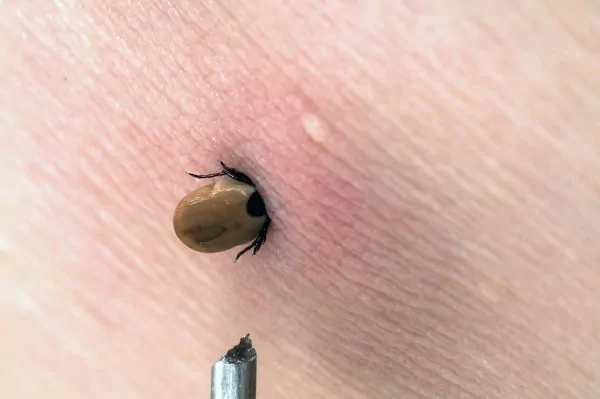
In this photo, the tick is still attached to the skin and appears larger because it has been feeding longer. This is an example of an engorged tick, then chosen because it has been gorging on claret.
Remove A Tick And Get It Tested Past IGeneX! – Learn More.
Other bug bites can sometimes resemble tick bites, and therefore, it isn't e'er easy to know whether you or a loved one have been bitten by a tick. The following guidelines can aid, simply information technology is ever best to consult with your healthcare provider if you suspect a tick bite.
- Tick bites are non fluid-filled, whereas bites from ants and other insects are typically pus-filled.
- Location can sometimes help distinguish tick bites from other insect bites because ticks virtually commonly bite the back of the neck, scalp, groin, and legs.
- Other problems bites, particularly those from fleas or bed bugs, may be multiple in number. Ticks typically bite once and then burrow their caput nether the pare.
Can you experience a tick seize with teeth?
Tick bites are painless, and so it'south likely yous won't immediately know that you've been bitten. The tick injects an anesthetic into the skin at its betoken of entry, which helps it avoid detection so it can continue feeding. Many patients with the tick-borne disease Lyme disease don't think having a bug bite of whatsoever kind.
Do ticks couch completely nether the skin?
In general, ticks practice not burrow completely under the skin. They burrow parts of their heads into the skin as they feed, a process that can last for upwardly to 10 days.
Rashes may (or may not) signal a tick-borne infection
A bulls-eye rash is often a telltale sign—not only of tick bite but of a potential Lyme disease infection. Other bug bites typically do not produce a rash with this distinctive pattern.
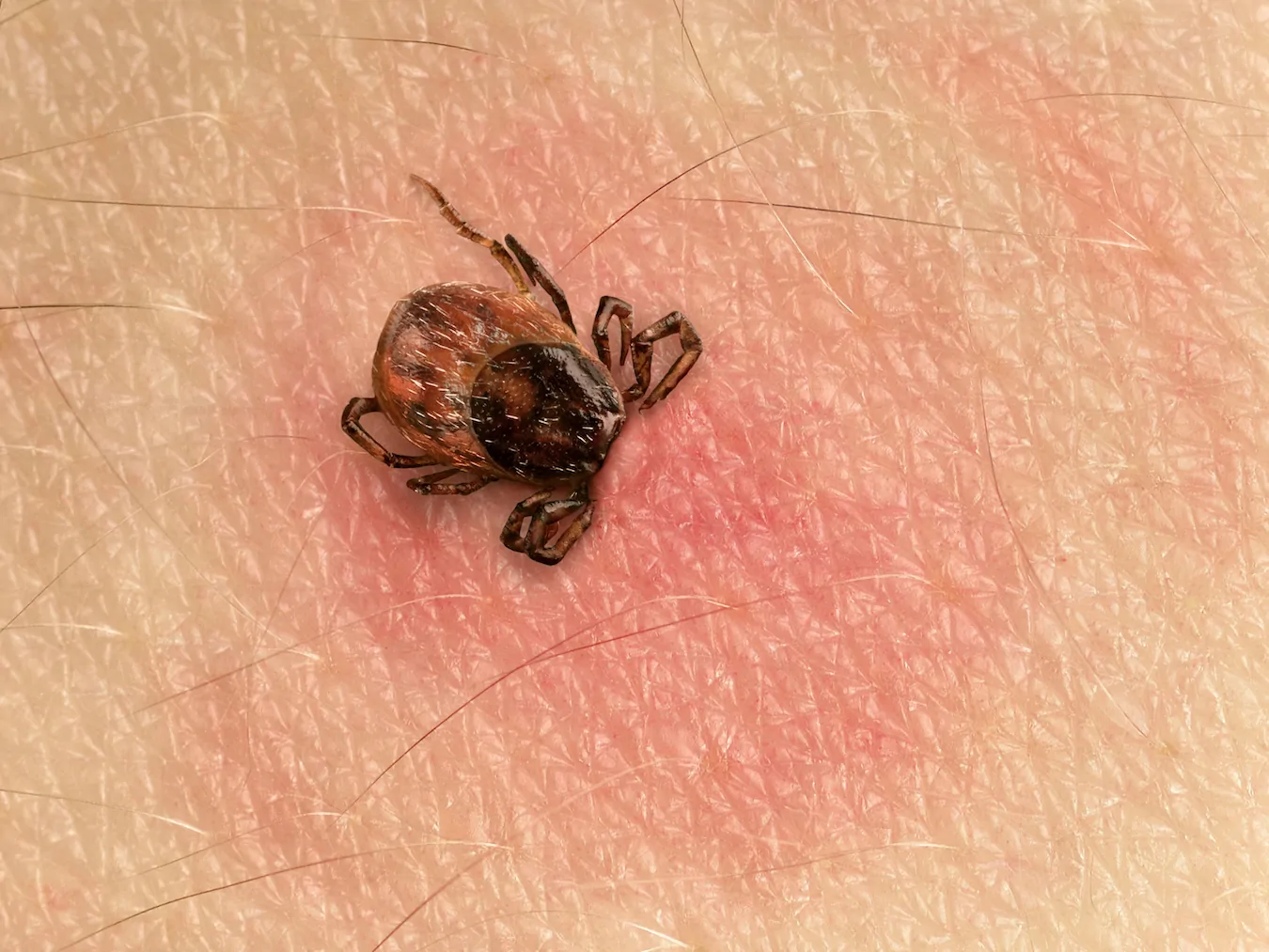
The skin is reddened in the area immediately surrounding the tick seize with teeth in this picture. Wait closely and you'll also come across another "ring" of redness farther out from the site. This is chosen a bulls-eye rash – besides known technically as erythema migrans (EM) rash – and appears only most 33 percent of the time when a person has been infected with Lyme affliction.
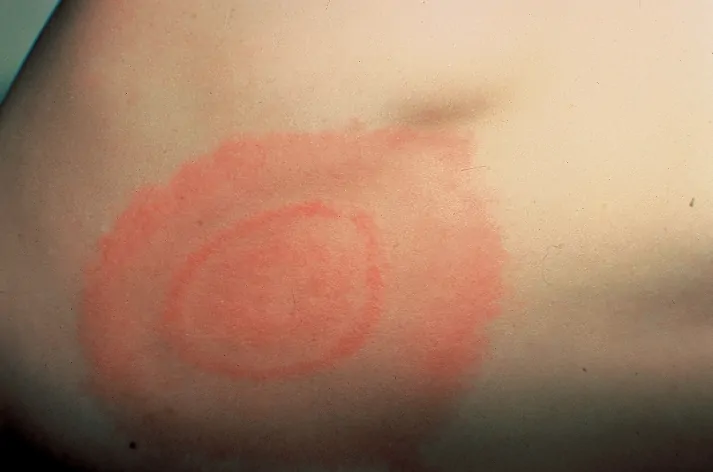
In this photo, you see the bull's-middle rash (EM) only no tick. 1 Chaaya, G., Jaller-Char, J.J., and Ali, S.Chiliad. "Beyond the Bull's Eye: Recognizing Lyme Affliction." Journal of Family Practise 65, no. six (June 2016): 373–9. https://pubmed.ncbi.nlm.nih.gov/27474818/.
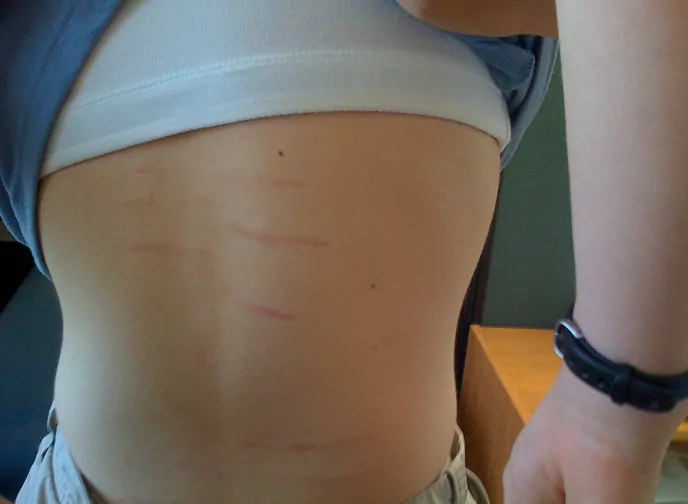
In this photo, you see the rash acquired past Bartonella.
Rashes may also point other types of tick-borne diseases, including tick-borne relapsing fever, Rocky Mountain Spotted Fever, Ehrlichiosis or Bartonellosis.
If y'all see this or any other rash pattern near a site, notify your healthcare provider immediately.
How long does a tick bite last?
It depends on several factors, including simple private differences equally well equally the presence or absence of infection. A tick seize with teeth may cause a small, red skin reaction no bigger than the size of a dime that tin terminal days to weeks. This does not necessarily indicate infection, only should be noted every bit a sign of possible exposure.
However, an erythema migrans rash – which is an early sign of Lyme – will grow in size over several days and tin can develop and grow within the first several weeks of infection.
How to safely remove a tick
If you see a tick still attached to the skin, remove it immediately. There are many ways to remove ticks, but some are more than constructive than others.
Commencement, preserving the tick tin assist your doctor determine whether information technology carries a potential disease in the event that y'all develop any symptoms following the bite. Smashing a tick that is attached to your skin can also release more toxins into your body, which can further betrayal yous to potential infectious diseases. And then even though your initial inclination may be to squash a tick that has attached to your skin, effort instead to go on information technology intact.
The following steps can aid you remove the tick rapidly and carefully:
- Grab the tick with pointed tweezers shut to the peel where it has burrowed in.
- Do not squeeze the tick—that may crusade more than pathogen-laced saliva to enter the torso.
- Pull upward with steady, even pressure. Exercise non twist or jerk the tick; this can cause mouth parts to break off and remain in the peel. Tick removal can get catchy if the tick'due south body breaks apart during removal. If this happens, try to tweeze out the remainder of the tick body or get out information technology in place and have a healthcare provider remove it as before long every bit possible.
- Y'all may hear a pop when the tick is removed.
- Place the tick in a ziplock pocketbook and close it tightly. Keep it in the freezer.
- Make clean the peel with alcohol and wash your hands.
- Do Non utilise cigarette butts or matches.
- If possible, send the tick in to be tested for disease. This can help determine your exposure to disease and also helps with general tick surveillance. Acquire more about getting a tick tested through IGeneX.
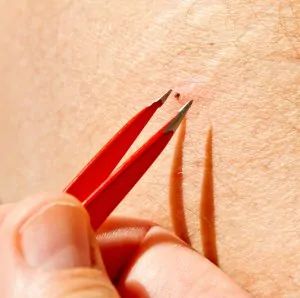
Catch the tick with pointed tweezers close to the peel where it has burrowed in.
Full general symptoms of tick-borne diseases
If infected with a tick-borne disease, symptoms more often than not start to nowadays themselves a few days after the bite. Although the symptoms vary based on the type of tick and the affliction it may be carrying, general signs to sentinel for include the post-obit:
- Mild itching
- Reddened area on the skin
- Very specific type of bulls-eye rash (EM) for Lyme
- Non-EM rash for other tick-related infections
- Fever
Some of the diseases carried by ticks include Borreliosis (Lyme disease and tick-borne relapsing fever—TBRF), Babesiosis, Ehrlichiosis, Bartonellosis, Anaplasmosis, Tularemia, and Rickettsiosis (including Rocky Mountain spotted fever). With certain diseases, symptoms may worsen over time. These may include memory loss, muscle weakness, fatigue, fevers that come and go, and declining cerebral functions.
Careful observation is an important start step after identifying whatever tick bite. Write down dates and circumstances of whatever bites you or a loved one encounter, along with any symptoms that present immediately or over time. If you see signs of a potential tick-borne illness, be sure to share this information with your healthcare provider. In many cases, patients and their doctors simply don't realize that a tick bite from several weeks or months ago is responsible for their affliction. Alerting healthcare providers every bit chop-chop as possible to whatever exposure to ticks may contribute to an before diagnosis of tick-borne illnesses.
Testing for tick borne diseases early and alerting healthcare providers equally quickly as possible to whatever exposure to ticks may contribute to an before diagnosis of tick-borne illnesses.
Source: https://igenex.com/tick-talk/identifying-tick-bites/
Posted by: woodaboody80.blogspot.com

0 Response to "What Does A Deer Tick Look Like That Just Burrowed Under Your Skin"
Post a Comment